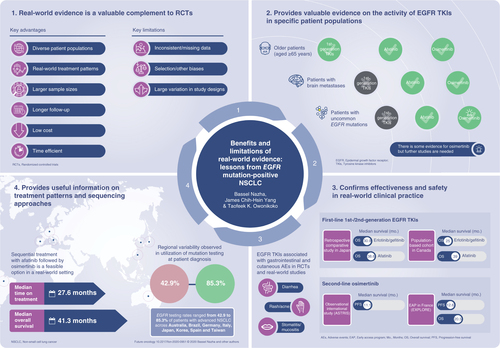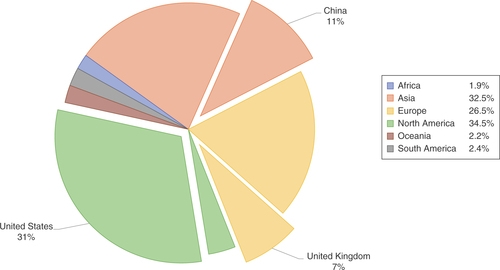The editorial team are pleased to welcome readers to the 18th volume of Future Oncology. As in previous years, we like to start this issue by taking a look at some content highlights from 2021 and updating you on all the work that the editors have done over the course of the year.
We are also very pleased to announce the journal’s impact factor increase to 3.660 and to welcome Lana Shkak to our editorial team as a new Commissioning Editor. Future Oncology has grown significantly over the pandemic and Lana will help us to ensure we continue publishing high quality content in a timely manner.
Thanks to successful vaccine rollouts in many parts of the world, the focus of 2021 has shifted much more on to recovery from the COVID-19 pandemic. Oncologists have begun to resume their research agendas and manage the backlog of cancer patients with delayed diagnoses or treatments. In this foreword, we will discuss some of this resumed research and explain how the journal adjusted during the pandemic.
Content highlights from 2021
Last year, the journal launched an initiative to help ensure that output from medical research is available in a format accessible to everyone, particularly patients [Citation1]. Not only has this driven the inclusion of lay abstracts, where possible, but we also aim to present the results of clinical studies more comprehensively in Plain Language Summaries of Publications. We are fortunate to have published a total of seven of these patient-friendly articles this year, one of which (Fizazi et al. ‘Darolutamide and survival in nonmetastatic, castration-resistant prostate cancer: a patient perspective of the ARAMIS trial’) was recently awarded ‘Most Valuable Awareness Initiative’ in Reuters' Global Pharma Awards 2021 [Citation2–4]. More of these articles are under development and we will continue to commission these exciting publications, so make sure you watch out for the latest news on this (www.plainlanguagesummaries.com).
Along with our plain language summary initiative, this year the journal published a special-focus issue on the topic of ‘Patient Engagement in Cancer Research’ with the help of Guest Editor, Deborah Collyar [Citation5]. While understanding the output of research is important, empowering patients to become valued contributors to research ensures that progress is made with patient benefit as the top priority. Articles in this special-focus issue discussed the role of patient engagement throughout the continuum of cancer care, including the pragmatic design of patient-centered clinical trials and strategies to increase uptake to cancer screening, as well as perspectives from patients on how to receive the best treatment [Citation6–8].
Two articles from this issue were particularly rewarding for us to work on, as they discussed very important issues under debate by both medical professionals and the wider public: financial toxicity and antiracism. In the Review by Gunn et al. authors discuss opportunities for patient engagement to reduce financial toxicity and explain the role of physicians, regulators and insurers in this regard [Citation9]. The article by Cheung et al. focuses on antiracist approaches to patient engagement in adolescent and young adult cancer patients, with pertinent discussions on existing practices and a strategy for improving ethical and effective engagement methods for racial and ethnic minority groups, which is based on the Patient-Centered Outcomes Research Institute (PCORI) Framework for Patient Engagement [Citation10].
Along with our patient initiatives, journal editors have been focused on bringing concise collections of past publications to our readers (www.tandfonline.com/journals/fon/collections). We feel this helps give a more complete picture of a given topic, or in some cases simply allows us to show the latest and greatest work from our authors. At the start of last year, we published series on clinical trial protocols, drug evaluations and our best open access content. We also published a collection of articles investigating cancer and COVID-19, which was well-received by a number of readers.
Unsurprisingly, articles discussing COVID-19 and the unique considerations for cancer patients continued to feature heavily throughout 2021; however, the focus of these manuscripts shifted from management guidance to reviews of actions taken during the pandemic and how this could help inform future practice, as well as interactions between cancer treatments and the COVID-19 vaccines [Citation11,Citation12].
shows the most highly-read content from Future Oncology from January to October 2021. The most read article, in total and exclusively during 2021, has again been the final analysis of the GioTag study from Hochmair et al. This was the culmination of a global observational study that had been accruing data since 2017, investigating the effect of sequential afatinib (Giotrif®) and osimertinib (Tagrisso®) on overall survival in EGFR-mutation-positive non-small-cell lung cancer patients. This manuscript remained popular, in part, due to the publication of another Plain Language Summary for the study [Citation13].
Table 1. Top three Future Oncology articles.
Our readers will be well aware that EGFR-mutant NSCLC has been at the forefront of discussions in the lung cancer space and has featured heavily at conferences throughout the year. It is therefore pleasing to see Nazha et al. leverage this to review the role of real-world evidence in cancer care and how the abundance of studies of real-world treatment and outcomes for this disease can set the benchmark for other cancers.
This manuscript also allows us to showcase another exciting aspect of our publications that has become more popular over the pandemic. Infographics (the example from Nazha et al. [Citation15] is shown in ) can provide readers with a snapshot of an article, helping them understand the content and encouraging them to read the paper in full, which our authors have made particular use of in place of in-person conferences and poster presentations.
AE: Adverse event; NSCLC: Non-small-cell lung cancer; RCT: Randomized controlled trial; TKI: Tyrosine kinase inhibitor.

Future Oncology have also continued our successful partnership with Altmetric to help authors measure the impact of their work more accurately. This year, special mention must go to the following articles who performed particularly highly:
Gounder et al. ‘Health-related quality of life and pain with selinexor in patients with advanced dedifferentiated liposarcoma’ – a study demonstrating the improvements in patient-reported outcomes and health-related quality of life for dedifferentiated liposarcoma treated with selinexor (Xpovio®) [Citation17];
Gajra et al. ‘Augmented intelligence to predict 30-day mortality in patients with cancer’ – authors describe the development of an artificial intelligence model for predicting patients at greatest risk for short-term mortality [Citation18];
Shanu Modi. ‘Trastuzumab deruxtecan in previously treated HER2-positive metastatic breast cancer: plain language summary of the DESTINY-Breast01 study’ – plain language summary of the DESTINY-Breast01 clinical trial, which featured heavily in clinical cancer conferences during 2021 [Citation19].
Social media has become a crucial tool for publishers to help spread their research, so it is gratifying to see the extra attention this is bringing to authors’ work. The journal’s twitter account (@FutureOncol_FSG) has gained more than 400 followers over the course of the year and we are hoping this continues to grow to help us disseminate research more quickly.
Demographics of Future Oncology
As well as looking back over the topics and the types of articles published in the journal, it is interesting to consider the source of the content () and where it is being read ().

Pulled out segments reflect the country with the highest readership on the continent.

We are continuing to receive high quality content from across the globe, most notably from Asia (38.5%), Europe (30.5%) and North America (27.2%). It is also pleasing to see an increase in impactful content from smaller or low and middle-income countries such as India and Lebanon. Our Senior Editor, Jackson Orem, has encouraged the submission of his team’s research to our journal, so we are pleased to have published some fantastic manuscripts from the Uganda Cancer Institute as well [Citation20].
Readership remains broad and well-distributed across the globe. The highest number of readers are still located in North America (34.5%) and Asia (32.5%), but thanks to increased submissions from a more diverse range of countries, Future Oncology’s readership has expanded to more areas of the world; most notably, South Korea and Taiwan. With the field of oncology continuing to advance so quickly, we look forward to seeing the global reach of the journal continue to grow.
As always, we are very grateful to all of our Editorial Board members, authors, peer reviewers and readers for supporting the journal, especially during such a challenging period of time. We look forward to working with you all again in 2022 – please do not hesitate to get in touch if you are interested in contributing to the journal.
Financial & competing interests disclosure
L Gautier and L Shkak are employees of Future Medicine Ltd, publisher of Future Oncology. The authors have no other relevant affiliations or financial involvement with any organization or entity with a financial interest in or financial conflict with the subject matter or materials discussed in the manuscript apart from those disclosed.
No writing assistance was utilized in the production of this manuscript.
Additional information
Funding
References
- Dormer L , WalkerJ. Plain language summary of publication articles: helping disseminate published scientific articles to patients. Future Oncol.16(25), 1873–1874 (2020).
- Fizazi K , BlueI, NowakJT. Darolutamide and survival in nonmetastatic, castration-resistant prostate cancer: a patient perspective of the ARAMIS trial. Future Oncol.17(4), 1699–1707 (2021).
- Oakin A , TinkerAV, GilbertLet al. Clinical activity and safety of the anti-PD-1 monoclonal antibody dostarlimab for patients with recurrent or advanced dMMR endometrial cancer. Future Oncol.17(29), 3781–3785 (2021).
- Bardia A , HurvitzSA, RugoHSet al. A plain language summary of the ASCENT study: sacituzumab Govitecan for metastatic triple-negative breast cancer. Future Oncol.17(30), 3911–3924 (2021).
- Collyar DE , GautierLJ. The importance and value of engaging patients in cancer research. Future Oncol.17(28), 3663–3666 (2021).
- Davies-Teye BB , MedeirosM, ChauhanC, BaquetCR, MullinsCD. Pragmatic patient engagement in designing pragmatic oncology clinical trials. Future Oncol.17(28), 3691–3704 (2021).
- Young B , RobbKA. Understanding patient factors to increase uptake of cancer screening: a review. Future Oncol.17(28), 3757–3775 (2021).
- Weker RB . Through the patient lens: how to be a cancer patient. Future Oncol.17(28), 3685–3690 (2021).
- Gunn AH , SorensonC, GreenupRA. Navigating the high costs of cancer care: opportunities for patient engagement. Future Oncol.17(28), 3729–3742 (2021).
- Cheung CK , Tucker-SeeleyR, DaviesS. A call to action: antiracist patient engagement in adolescent and young adult oncology research and advocacy. Future Oncol.17(28), 3743–3756 (2021).
- Spartalis E , PlakopitisN, TheodoriMAet al. Thyroid cancer surgery during the coronavirus disease 2019 pandemic: perioperative management and oncological and anatomical considerations. Future Oncol.doi:10.2217/fon-2021-0585 (2021) ( Epub ahead of print).
- Karacin C , ErenT, ZeynelgilEet al. Immunogenicity and safety of the CoronaVac vaccine in patients with cancer receiving active systemic therapy. Future Oncol.17(33), 4447–4456 (2021).
- Hochmair MJ . Plain language summary of the final results from the GioTag study. Future Oncol.17(25), 3285–3290 (2021).
- Hochmair MJ , MorabitoA, HaoDet al. Sequential afatinib and osimertinib in patients with EGFR mutation-positive non-small-cell lung cancer: final analysis of the GioTag study. Future Oncol.16(34), 2799–2808 (2021).
- Nazha B , YangJCH, OwonikokoTK. Benefits and limitations of real-world evidence: lessons from EGFR mutation-positive non-small-cell lung cancer. Future Oncol.17(8), 965–977 (2021).
- Chung HC , BangYJ, FuchsCSet al. First-line pembrolizumab/placebo plus trastuzumab and chemotherapy in HER2-positive advanced gastric cancer: KEYNOTE-811. Future Oncol.17(5), 491–501 (2021).
- Gounder M , AbdulRazak AR, GilliganAMet al. Health-related quality of life and pain with selinexor in patients with advanced dedifferentiated liposarcoma. Future Oncol.17(22), 2923–2939 (2021).
- Gajra A , ZettlerME, MillerKAet al. Augmented intelligence to predict 30-day mortality in patients with cancer. Future Oncol.17(29), 3797–3807 (2021).
- Modi S . Trastuzumab deruxtecan in previously treated HER2-positive metastatic breast cancer: plain language summary of the DESTINY-Breast01 study. Future Oncol.17(26), 3415–3423 (2021).
- Osinde G , NiyonzimaN, MulemaVet al. Increasing access to quality anticancer medicines in low- and middle-income countries: the experience of Uganda. Future Oncol.17(21), 2735–2745 (2021).
